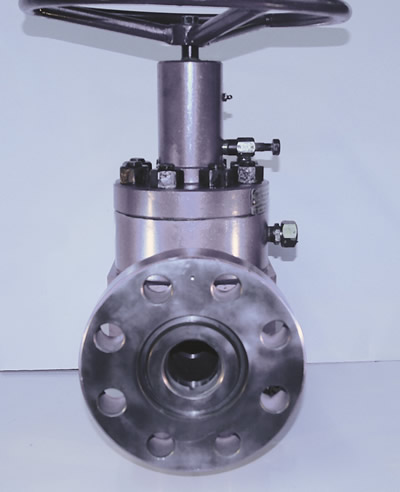Metal performance characteristics—such as strength, stiffness and corrosion resistance—have traditionally been controlled by either varying the alloy chemistry via what’s added to the melt or by altering its microstructure through some type of post-production treatment or mechanical means. Modumetal Inc. has added a third control “dial” to this list with its electrochemical nanolamination process, an advanced form of electroplating, which creates architected interfaces in the metal, according to CEO Christina Lomasney.
“The same basic raw materials that are used in metals manufacturing today we can architect in a very different way and produce materials that outperform what we thought was the limit with those types of alloys,” she said.
“We’re producing layered alloys,” she added. “The laminated alloys are kind of like plywood, but, in our case, the plies are on the nanometer scale.”

Modumetal produces completed components from its nanolaminated materials, such as this gate valve. Image courtesy Modumetal.
The layer thickness ranges from a single nanometer to hundreds of nanometers and even up into the micron level. To create the layered structure, the company reports that is uses a bath containing more than one kind of metal ion and controls how ions are deposited by varying the electrical current at precise moments. According to Lomasney, predictably depositing an alloy composition requires a high level of process control, “as well as an intimate understanding and control of the electrochemical species in the solution.”
The company’s primary focus is on enhancing the wear and corrosion characteristics of metals for oil and gas applications, which are often exposed to chemicals that quickly damage production equipment, as well as other industries that are on a quest for enhanced part performance—but not at any cost, Lomasney said. “The cost-benefit is core to the mission of the company. We are cost neutral and, in some cases, a less-expensive alternative and yet we are able to extend this performance envelope quite significantly.”
Parts with the nanolayering architecture have been in oilfields for more than a year and are showing significant performance improvements compared with ones made from conventional, homogenous-state materials, she said.
The company makes parts, such as tubular joints, valves, fasteners and connectors, to near-net or final shape at its production facility in Snohomish County, Wash. Being able to significantly reduce finishing operations is beneficial for Modumetal, not only because it doesn’t have a machining center, but also because of the machinability of nanolaminated metal, Lomasney noted. “We have some good friends in Seattle here who have helped us out a few times when we had to machine our parts. Their guys came back and said, ‘We chewed through quite a few tool bits trying to cut this material. What the heck is it? Maybe you should consider making the tool bits out of it instead,’”she said.
Modumetal is also exploring how to apply its technology in the automotive industry, she added. Nanolamination can reduce a vehicle’s weight without sacrificing material strength, making car bodies lighter without compromising safety. The result is a more energy-efficient vehicle.
“The significance of being able to deliver that dramatic increase in strength is that you can basically run the equation the other way and say we can achieve a similar level of protection in a car with a lot less material,” Lomasney explained, noting the company’s initial work involved armor applications. “We continue to focus on developing those aspects of the material for lightweighting of structural material.”
In addition to being used to make parts and bulk materials, the technology can be employed to deposit a coating on a metal part to structurally reinforce it.
For more information about Modumetal Inc., Seattle, call (877) 632-4242 or visit www.modumetal.com. CTE
About the Author: Alan Richter is editor of CTE. Contact him at (847) 714-0175 or [email protected].
Related Glossary Terms
- alloys
alloys
Substances having metallic properties and being composed of two or more chemical elements of which at least one is a metal.
- machinability
machinability
The relative ease of machining metals and alloys.
- machining center
machining center
CNC machine tool capable of drilling, reaming, tapping, milling and boring. Normally comes with an automatic toolchanger. See automatic toolchanger.
- micron
micron
Measure of length that is equal to one-millionth of a meter.
- microstructure
microstructure
Structure of a metal as revealed by microscopic examination of the etched surface of a polished specimen.
- process control
process control
Method of monitoring a process. Relates to electronic hardware and instrumentation used in automated process control. See in-process gaging, inspection; SPC, statistical process control.
- stiffness
stiffness
1. Ability of a material or part to resist elastic deflection. 2. The rate of stress with respect to strain; the greater the stress required to produce a given strain, the stiffer the material is said to be. See dynamic stiffness; static stiffness.







